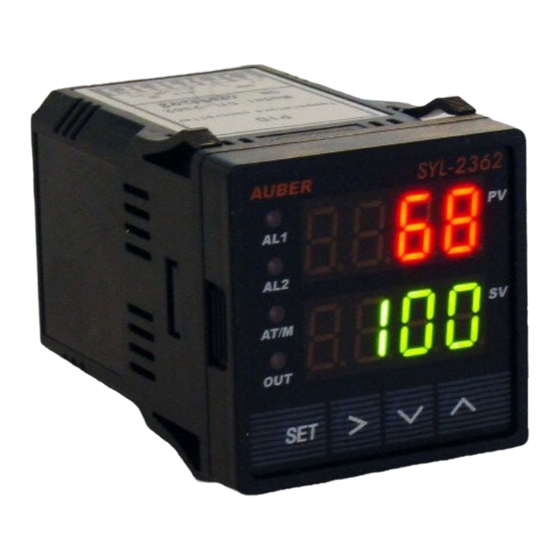- ページ 4
温度コントローラー Auber Instruments SYL-2362A2のPDF 取扱説明書をオンラインで閲覧またはダウンロードできます。Auber Instruments SYL-2362A2 6 ページ。

AUBER INSTRUMENTS
Table 4. Temperature and alarm parameters
Symbol
Target temperature
SV
SV
AH1
AH1
J1 on temperature
AL1
J1 off temperature
AL1
AH2
J2 on temperature
AH2
AL2
J2 off temperature
AL2
END
END
Note 12. There are two ways to set the target temperature:
a. During the normal operation mode, press ^ or V keys once to switch the
display from PV to set value. The display will start to blink. Press ^ or V keys
again to increase or decrease the SV. When finished, wait 8 seconds and the
settings will take effect automatically (the display will stop blinking).
b. Press SET key once. Use >, ^ and V keys to enter code 0001. Press SET key
to confirm, then the display would be SV (Su). Press SET key again to display
the SV setting. Use >, ^ and V keys to enter the new SV value and press SET
key to confirm. Press V key to change the display to END. Then, press SET key
to exit. You can also ignore the steps after confirmation of SV. The controller will
returns to normal operation mode automatically if no key is pressed for 1 minute.
This method is easier for large temperature change.
Note 13. Alarm setting. The J1 relay is controlled by parameters AH1 and AL1.
And the J2 relay is controlled by parameter AH2 and AL2. AH1 (or AL2) is the
temperature to turn the J1 (or J2) relay on; AL1 (or AL2) is the temperature to turn
the J1 (or J2) relay off. When AH1>AL1 (or AH2>AL2), the J1 (or J2) alarm is set
for absolute high alarm as shown in Figure 5 below. When AH1 <AL1 (or
AH2<AL2), the J1 (or J2) alarm is set for absolute low alarm as shown in Figure 6
below. When AH1=AL1 (or AH2=AL2), the J1 (or J2) alarm is deactivated.
Please note that J2 can't be used as alarm when "outy" is set to 1, 4 or 5.
PV
AH1
AL1
SV
Relay on
Figure 5. Absolute high alarm
6. Auto-Tuning
The Auto-tuning function (also called self-tuning) can automatically optimize the
PID parameters for the system. The auto-tuning function will use the On/off mode
to heat up the system until it passes the set point. Then let it cool down. It will
repeat this about three times. Based on the response time of the system, the built-
in artificial intelligence program will calculate and set the PID parameters for the
controller. If your system has a very slow response, the auto-tuning could take a
long time.
2021.10
Initial
Description
Setting
800
(Set Value)
800
900
800
900
Exit
AL1
AH1
SV
Relay on
Figure 6. Absolute low alarm
Note
12
13
6.1 To activate Auto-tuning, press and hold > key until the "AT" indicator starts to
blink, which indicates auto-tuning is in progress. When "AT" stops blinking, the
auto-tuning is finished. Now, newly calculated PID parameters are set to be used
for the system. Please note that Auto-tuning is only for PID control mode (when
"outy" is set at 1 or 2).
6.2 To stop the Auto-tuning, press and hold > key until "AT" indicator stops blinking.
Then, the previous PID parameters values are resumed.
7. On/off control mode
On/off control mode is not as precise as PID control mode. However, it is
necessary for inductive loads such as motors, compressors, or solenoid valves
that do not like to take pulsed power. It works like a mechanical thermostat. When
the temperature passes the set point, the heater (or cooler) will be turned off. When
the temperature drops back to below the hysteresis band (dead band) the heater
will be turned on again.
To use the on/off mode, set Outy to 3 or 4 depending on the output device to be
used. Then, set the Hy to the desired range based on control precision
requirements. Smaller Hy values result in tighter temperature control, but also
cause the on/off action to occur more frequently. In the PID parameters menu
(code 0036), only ot and FILt are used. P, I, D and SouF are not meaningful.
PV
100
97
8. Manual mode
Manual mode allows the user to control the output as a percentage of the total
heater power. It is like a stove dial. The output is independent of the temperature
sensor reading. One application example is controlling the strength of boiling
during beer brewing. You can use the manual mode to control the boiling so that
it will not boil over to make a mess. The manual mode can be switched from PID
mode but not from On/off mode. To switch from the PID to the manual mode, press
and hold the SET key until the "AT/M" indicator turned on (about 5 seconds). In
the manual mode, the top display is for the process temperature. The bottom right
is the percentage of power output. The bottom left display show an "M" for user
to easily identify the controller is in manual mode. To switch from manual to PID
WWW.AUBERINS.COM
AT end
AT start
AT calculation
PV
SV
ON OFF
ON OFF
ON/OFF
PID
Figure 7. Auto-tuning
PV
When heating, and outy = 3 or 4,
SV
If PV (SV - Hy), relay on
SV-Hy
If PV SV, relay off
(SV = 100, Hy = 3)
Relay On
Figure 8. On/off control mode
P4/6
